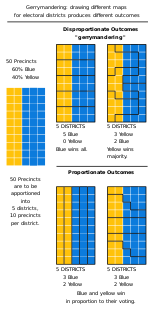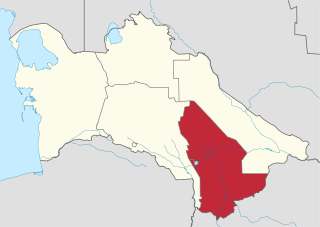This page is based on this
Wikipedia article Text is available under the
CC BY-SA 4.0 license; additional terms may apply.
Images, videos and audio are available under their respective licenses.

Gerrymandering is a practice intended to establish a political advantage for a particular party or group by manipulating district boundaries. The resulting district is known as a gerrymander ; however, that word is also a verb for the process. The term gerrymandering has negative connotations. Two principal tactics are used in gerrymandering: "cracking" and "packing". A third tactic, shown in the top-left diagram in the graphic to the right, is homogenization of all districts.

Ho Chi Minh City, mostly known as Saigon, is the most populous city in Vietnam with a population of 8.4 million as of 2017. Located in southeast Vietnam, the metropolis surrounds the Saigon River and covers about 2,061 square kilometres.

The United States district courts are the general trial courts of the United States federal court system. Both civil and criminal cases are filed in the district court, which is a court of law, equity, and admiralty. There is a United States bankruptcy court associated with each United States district court. Each federal judicial district has at least one courthouse, and many districts have more than one. The formal name of a district court is "the United States District Court for" the name of the district—for example, the United States District Court for the Eastern District of Missouri.

A central business district (CBD) is the commercial and business center of a city. In larger cities, it is often synonymous with the city's "financial district". Geographically, it often coincides with the "city centre" or "downtown", but the two concepts are separate: many cities have a central business district located away from its commercial or cultural city centre or downtown.

A red-light district or pleasure district is a part of an urban area where a concentration of prostitution and sex-oriented businesses, such as sex shops, strip clubs, and adult theaters, are found. Areas in many big cities around the world have acquired an international reputation as red-light districts.
A school district is a special-purpose district that operates local public primary and secondary schools in various nations.

The districts of England are a level of subnational division of England used for the purposes of local government. As the structure of local government in England is not uniform, there are currently four principal types of district-level subdivision. There are a total of 326 districts made up of 36 metropolitan boroughs, 32 London boroughs, 201 non-metropolitan districts, and 55 unitary authorities, as well as the City of London and the Isles of Scilly which are also districts, but do not correspond to any of these categories. Some districts are styled as boroughs, cities, or royal boroughs; these are purely honorific titles, and do not alter the status of the district. All boroughs and cities, and a few districts, are led by a mayor who in most cases is a ceremonial figure elected by the district council, but—after local government reform—is occasionally a directly elected mayor who makes most of the policy decisions instead of the council.

In the United States, a district attorney (DA) is the chief prosecutor for a local government area, typically a county. The exact name of the office varies by state.

United States attorneys represent the United States federal government in United States district courts and United States courts of appeals.

Mary Region is one of the regions of Turkmenistan. It is located in the south-east of the country, bordering Afghanistan. Its capital is the city of Mary. Its area is 87,150 km2 (33,650 sq mi) and population 1,480,400. The average population density is about 15 persons per square kilometer, but it reaches 150-200 per square kilometer in the most developed oases.
An electoral district, (election) precinct, election district, or legislative district, called a voting district by the US Census is a territorial subdivision for electing members to a legislative body. Generally, only voters (constituents) who reside within the district are permitted to vote in an election held there. From a single district, a single member or multiple members might be chosen. Members might be chosen by a first-past-the-post system or a proportional representative system, or another voting method entirely. Members might be chosen through a direct election under universal suffrage, an indirect election, or another form of suffrage.

In the law regulating historic districts in the United States, a contributing property or contributing resource is any building, object, or structure which adds to the historical integrity or architectural qualities that make the historic district, listed locally or federally, significant. Government agencies, at the state, national, and local level in the United States, have differing definitions of what constitutes a contributing property but there are common characteristics. Local laws often regulate the changes that can be made to contributing structures within designated historic districts. The first local ordinances dealing with the alteration of buildings within historic districts was in Charleston, South Carolina in 1931.












